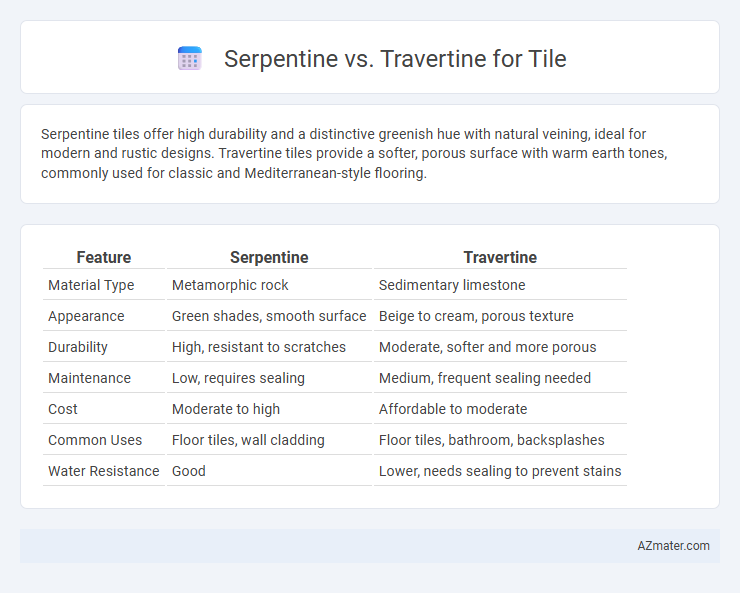Serpentine tiles offer high durability and a distinctive greenish hue with natural veining, ideal for modern and rustic designs. Travertine tiles provide a softer, porous surface with warm earth tones, commonly used for classic and Mediterranean-style flooring.
Table of Comparison
| Feature | Serpentine | Travertine |
|---|---|---|
| Material Type | Metamorphic rock | Sedimentary limestone |
| Appearance | Green shades, smooth surface | Beige to cream, porous texture |
| Durability | High, resistant to scratches | Moderate, softer and more porous |
| Maintenance | Low, requires sealing | Medium, frequent sealing needed |
| Cost | Moderate to high | Affordable to moderate |
| Common Uses | Floor tiles, wall cladding | Floor tiles, bathroom, backsplashes |
| Water Resistance | Good | Lower, needs sealing to prevent stains |
Introduction to Serpentine and Travertine Tiles
Serpentine tiles, derived from metamorphic rock rich in magnesium silicate, offer a distinctive deep green color with veined patterns that enhance interior aesthetics. Travertine tiles consist of sedimentary limestone formed by mineral springs, characterized by porous textures and warm earth-tone hues, commonly used in flooring and wall cladding. Both materials provide durable, natural stone options with unique visual appeals suited for various design styles and applications.
Origins and Composition of Serpentine and Travertine
Serpentine originates from the metamorphic alteration of ultramafic rocks and is primarily composed of magnesium-rich silicate minerals, giving it a distinctive green color and smooth texture. Travertine forms through the rapid precipitation of calcium carbonate from mineral-rich spring water, resulting in a porous, sedimentary stone with a characteristic layered appearance. The differing geological formation and mineral compositions influence their durability and visual appeal in tile applications.
Appearance and Color Variations
Serpentine tiles showcase a rich spectrum of green hues, ranging from deep emerald to lighter olive shades, often interspersed with white or gold veining that adds intricate texture and depth. Travertine offers a more earthy palette, featuring warm beige, cream, and rust tones with characteristic porous textures and naturally occurring pits that can be filled for a smoother finish. Both materials bring distinctive aesthetic appeals, with serpentine providing a bold, luxurious look and travertine delivering a timeless, rustic charm.
Durability and Hardness Comparison
Serpentine tiles typically exhibit Mohs hardness values ranging from 3 to 6, making them softer and more prone to scratching compared to travertine, which has a hardness of about 6 to 7. Travertine's dense, porous composition contributes to greater durability and resistance to wear, especially in high-traffic areas, whereas serpentine's lower density results in less impact resistance. For flooring and surfaces requiring longevity and toughness, travertine offers superior hardness and durability compared to serpentine tiles.
Water and Stain Resistance Factors
Serpentine tiles exhibit moderate water resistance due to their dense crystal structure, making them suitable for low-moisture areas, while travertine tiles are more porous and require sealing to prevent water absorption and damage. Travertine's natural pitting and open pores increase its susceptibility to staining, necessitating regular maintenance with impregnating sealers to enhance stain resistance. Serpentine, with fewer surface pits and a tighter grain, generally offers better stain resistance, reducing the risk of discoloration in kitchens and bathrooms.
Installation Challenges and Tips
Serpentine tiles often present installation challenges due to their variable hardness, requiring diamond-tipped blades and precise cutting techniques to avoid uneven edges and cracking. Travertine tiles pose difficulties with porosity and surface irregularities, necessitating thorough sealing before and after installation to prevent staining and water damage. Proper substrate preparation and using flexible thin-set mortar are essential for both materials to ensure long-lasting adhesion and minimize tile movement.
Maintenance Requirements for Both Stones
Serpentine tiles require regular sealing to prevent staining and maintain their vibrant green hues, as they are more porous and susceptible to etching from acidic substances. Travertine tiles demand frequent cleaning and sealing to protect their natural pores from dirt and moisture, with more attention needed in high-traffic areas to avoid surface wear and discoloration. Both stones benefit from non-abrasive cleaners and prompt spill management to preserve their appearance and durability over time.
Cost Analysis: Serpentine vs Travertine
Serpentine tiles typically cost between $5 to $15 per square foot, while travertine tiles range from $3 to $10 per square foot, making travertine generally more budget-friendly. The installation cost for both materials varies based on tile size and site conditions but is often slightly higher for serpentine due to its hardness and cutting difficulty. Maintenance expenses are comparable, though travertine may require more frequent sealing to prevent staining and damage.
Ideal Applications and Best Use Cases
Serpentine tiles, known for their rich green hues and unique marbling, excel in luxurious interior applications such as bathroom walls, countertops, and accent flooring where durability and aesthetic appeal are critical. Travertine, with its earthy tones and porous texture, is ideal for outdoor patios, pool surrounds, and rustic indoor spaces that benefit from its slip resistance and natural, weathered look. Both stones perform well in commercial and residential settings, but serpentine's higher hardness suits high-traffic areas, while travertine's breathability makes it preferable for humid environments.
Pros and Cons of Serpentine and Travertine Tiles
Serpentine tiles offer high durability and a striking green to dark color range, making them ideal for bold design statements but require regular sealing due to their porosity. Travertine tiles provide a classic, warm aesthetic with natural pits and a lighter color palette, enhancing rustic or traditional spaces, yet they can be more susceptible to scratching and staining without proper maintenance. Both stone options demand careful care to preserve their beauty, but serpentine's toughness often suits high-traffic areas better than the more delicate travertine.

Infographic: Serpentine vs Travertine for Tile
 azmater.com
azmater.com